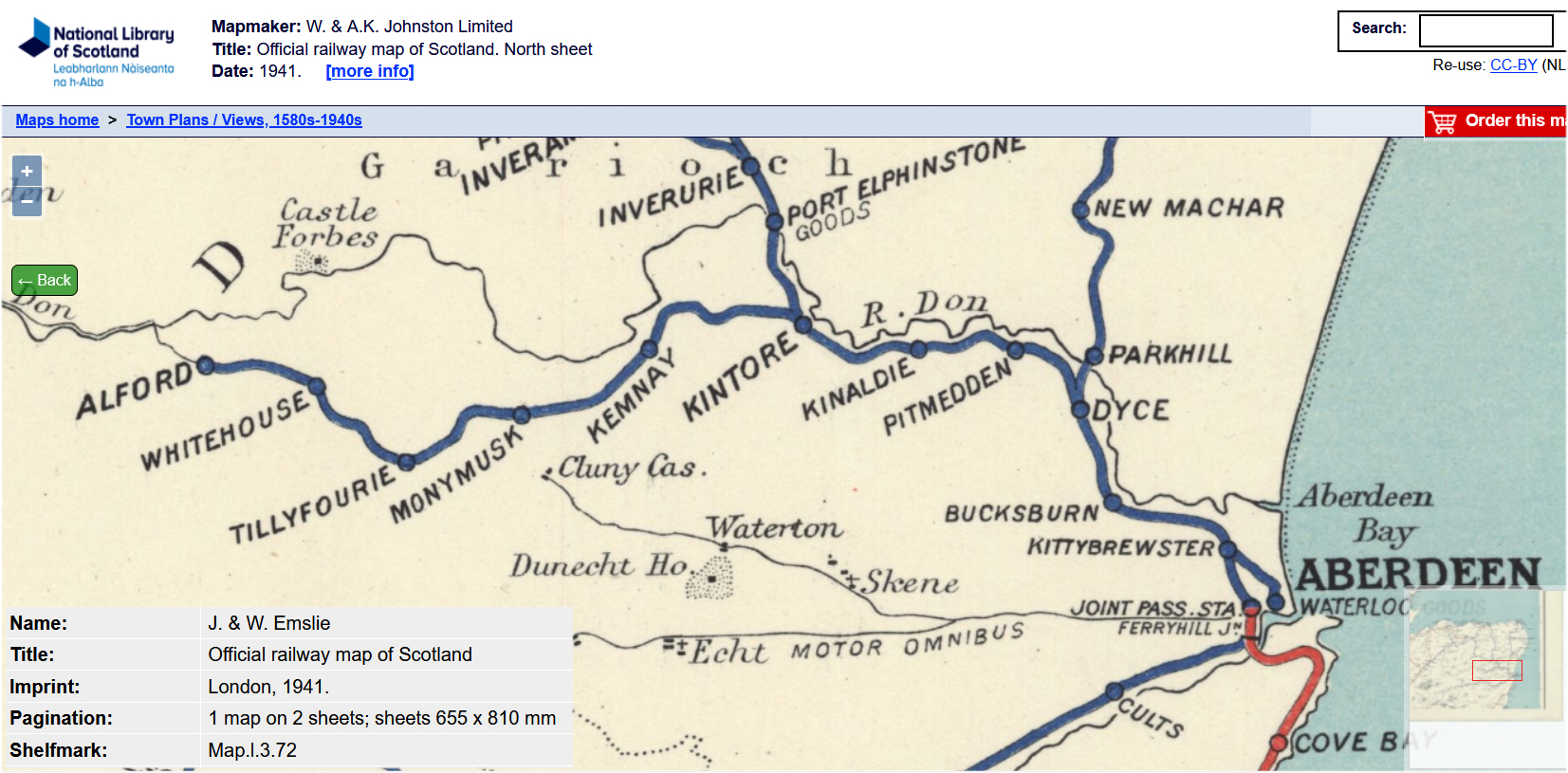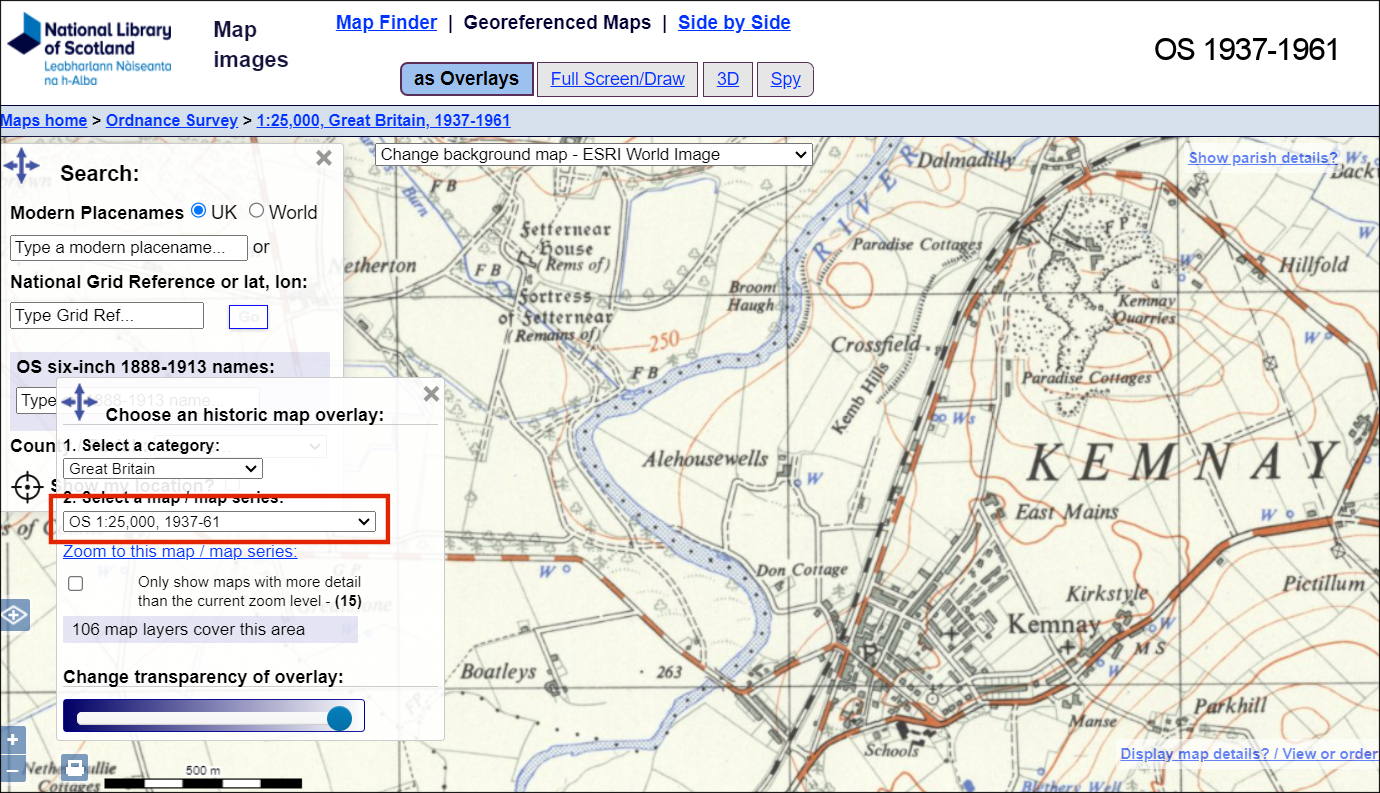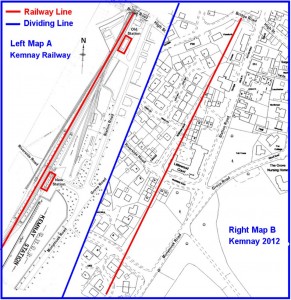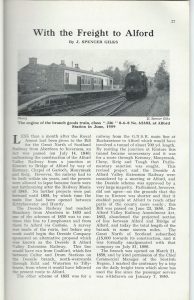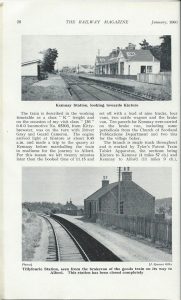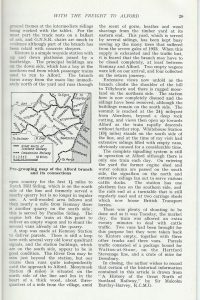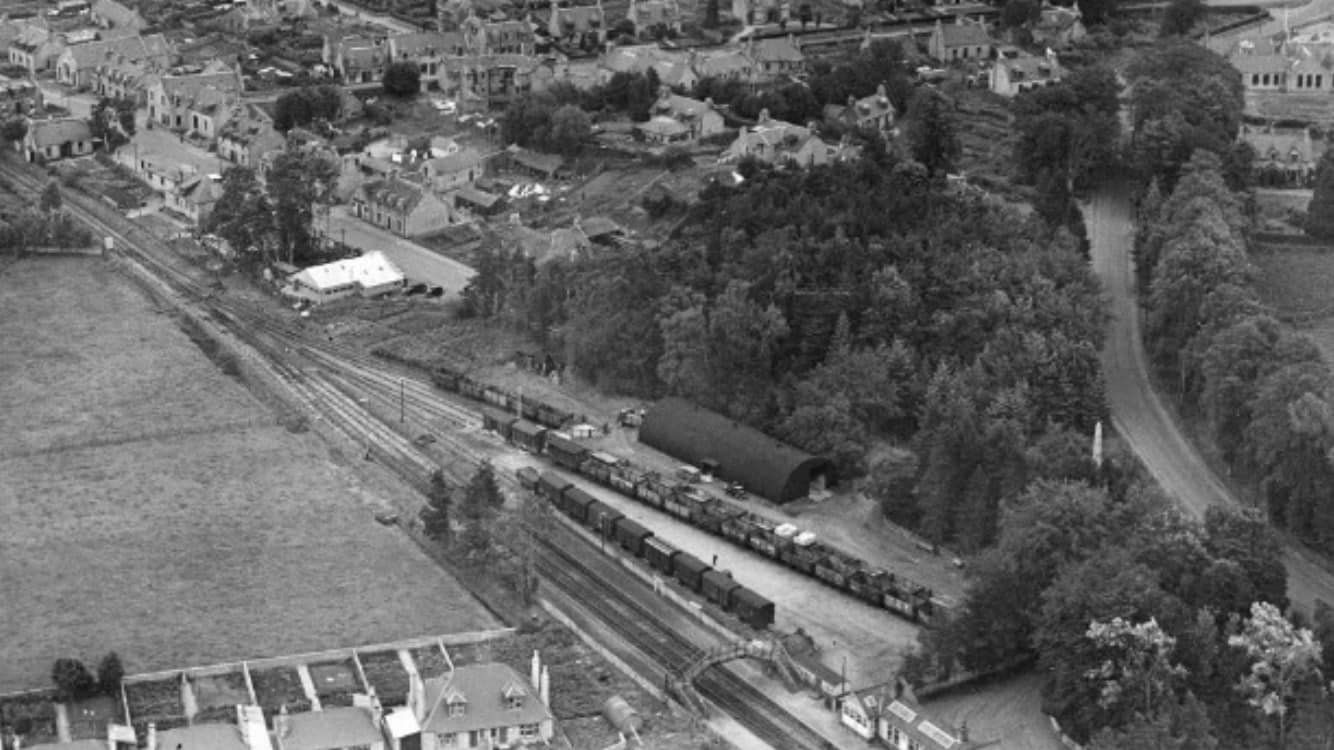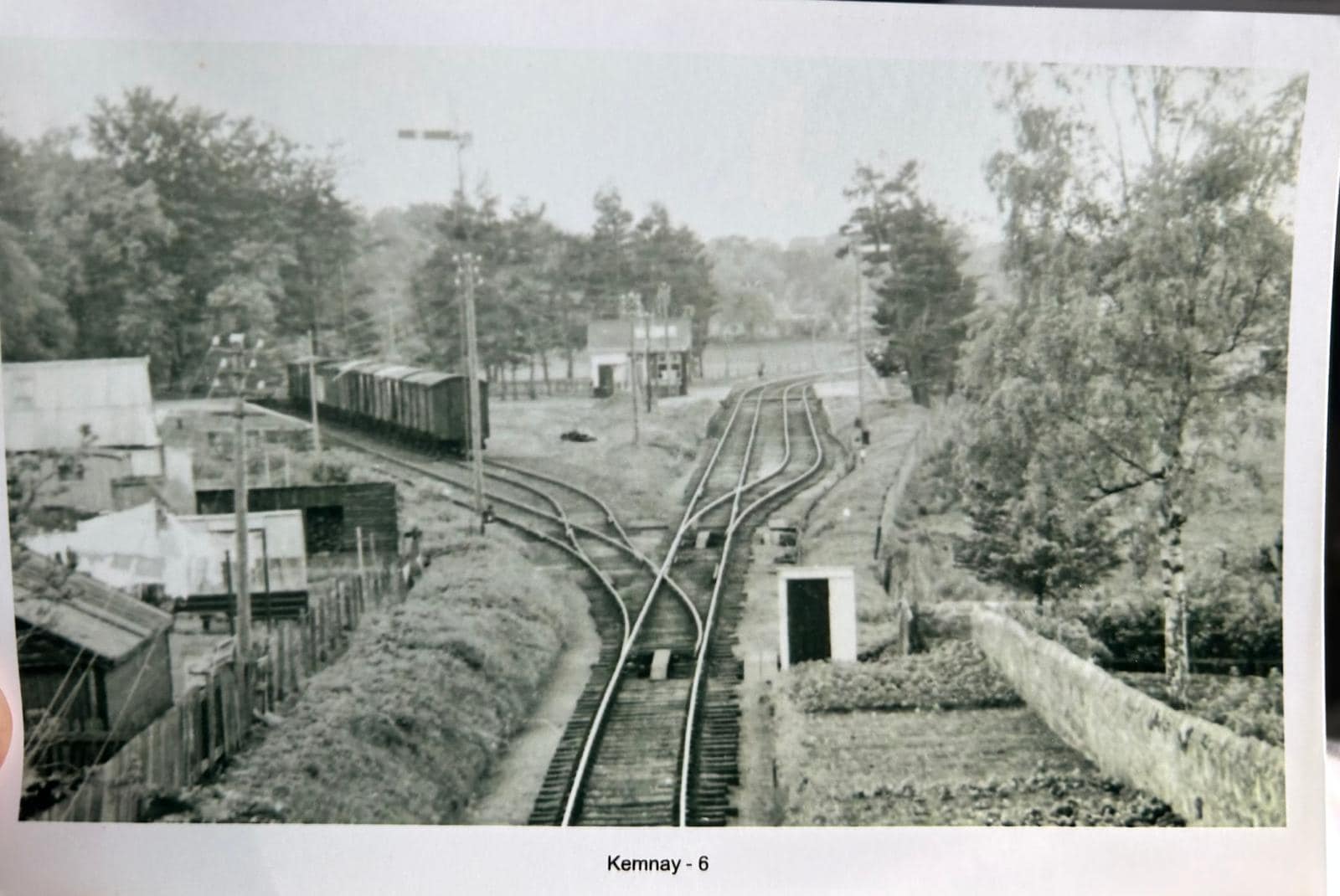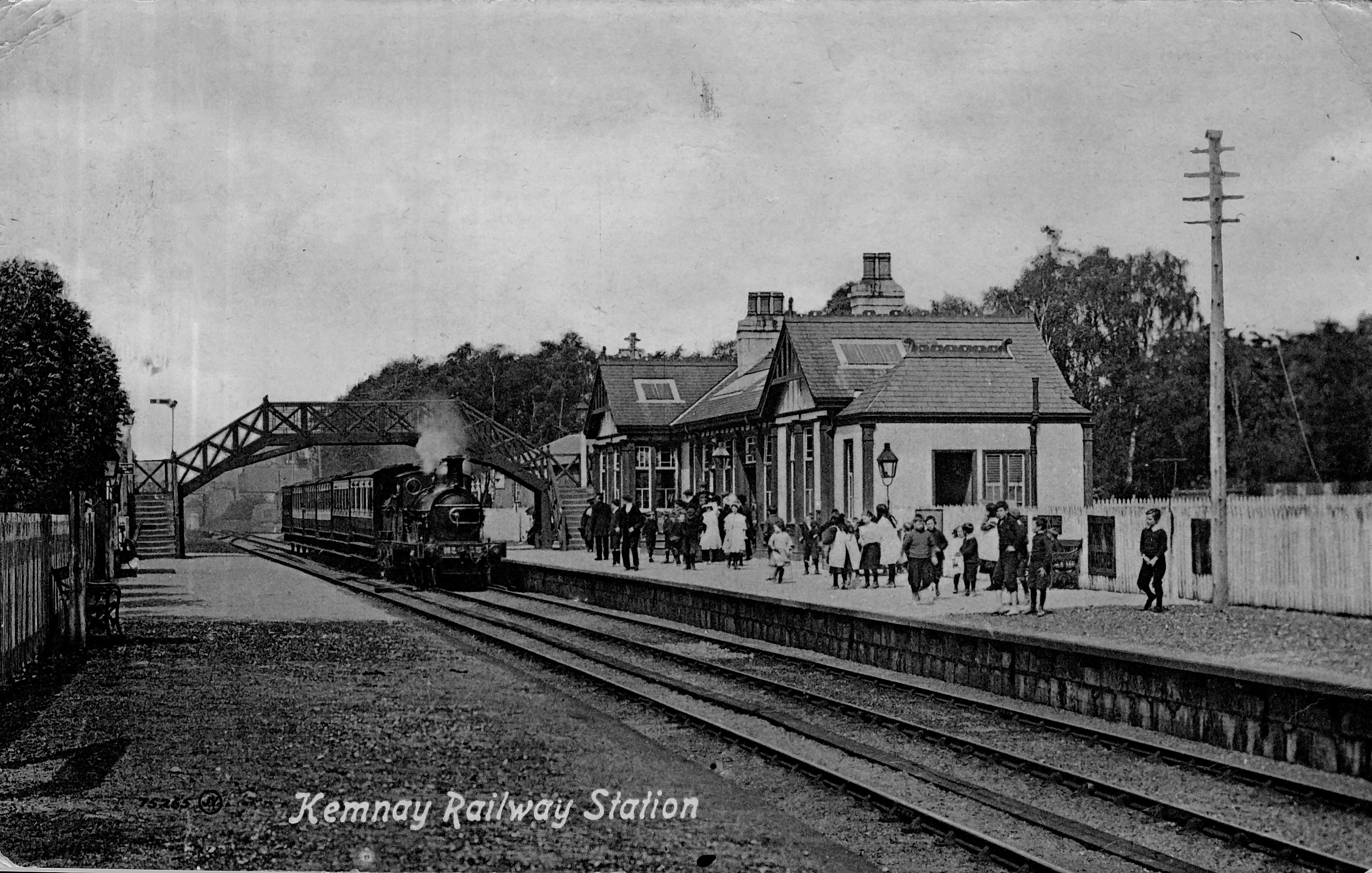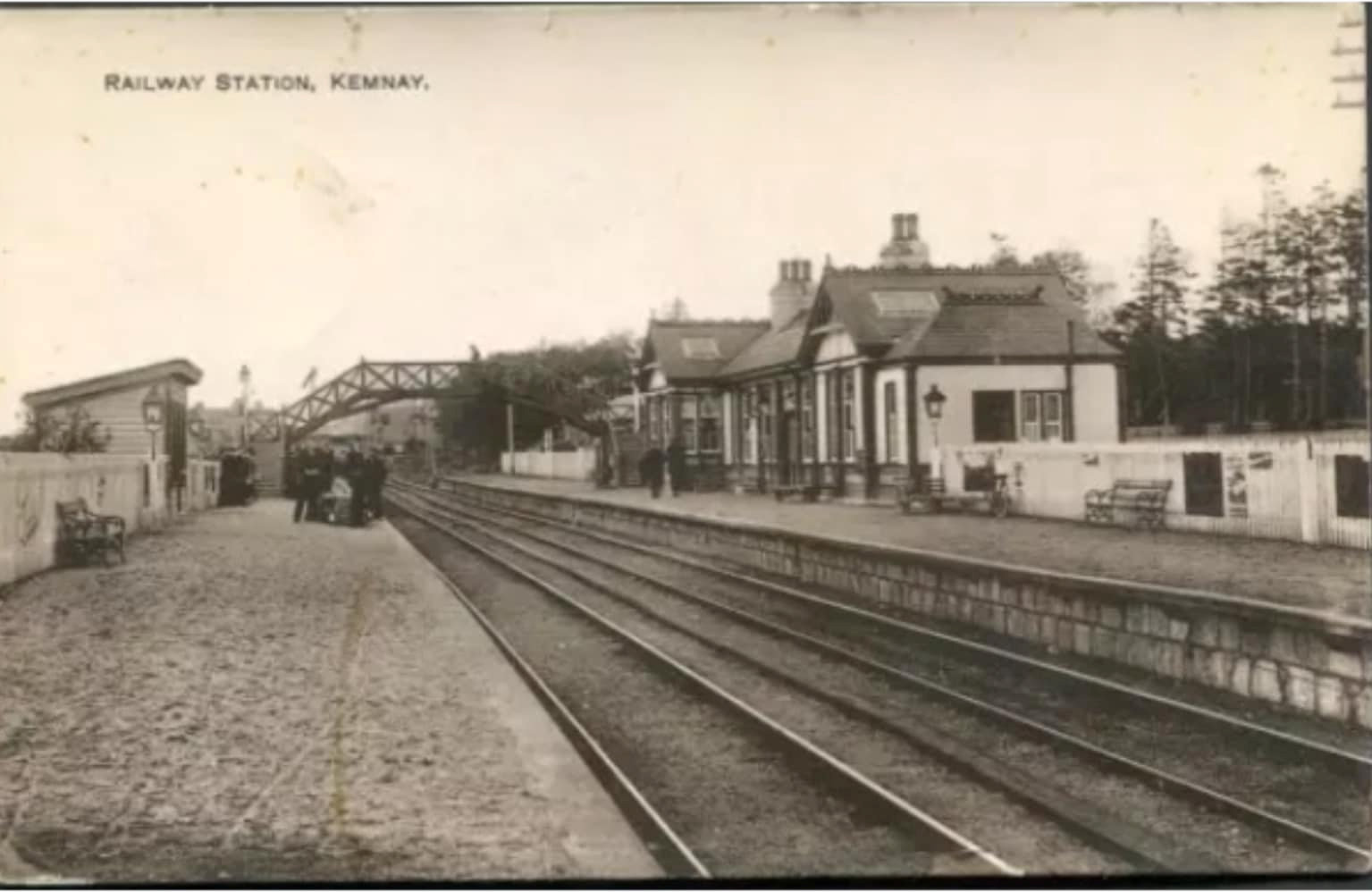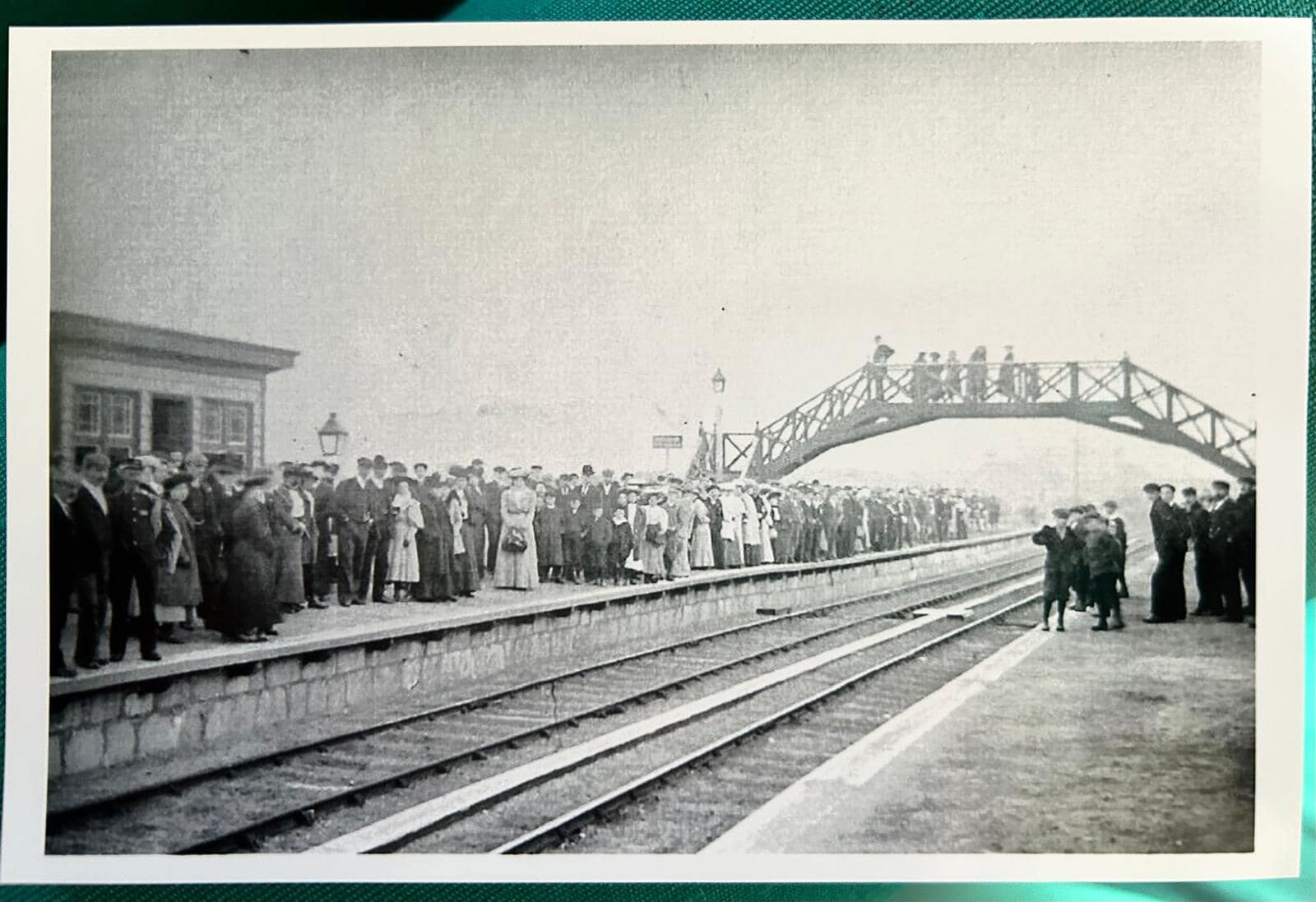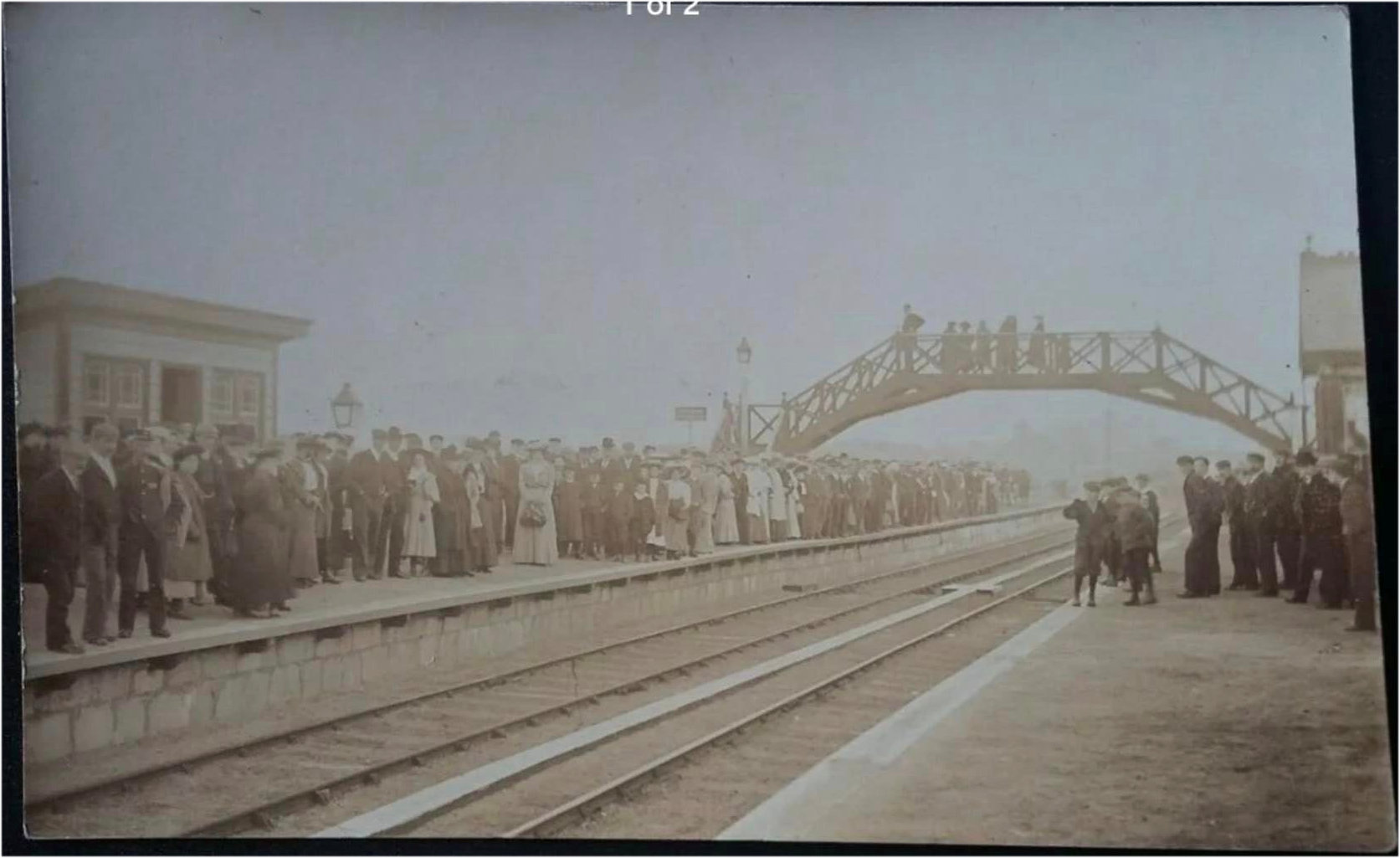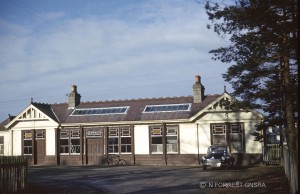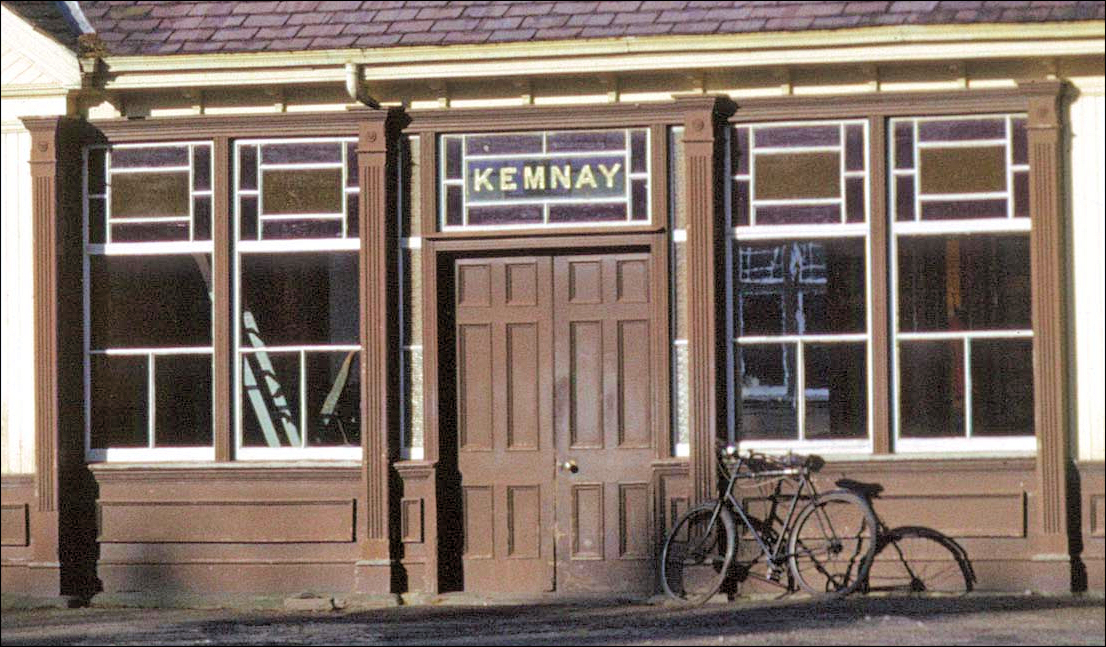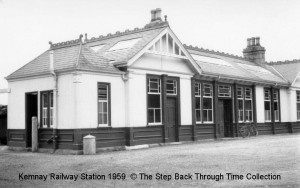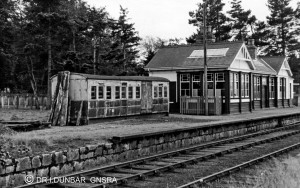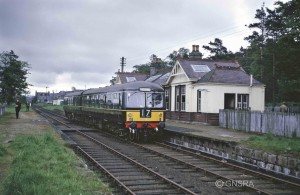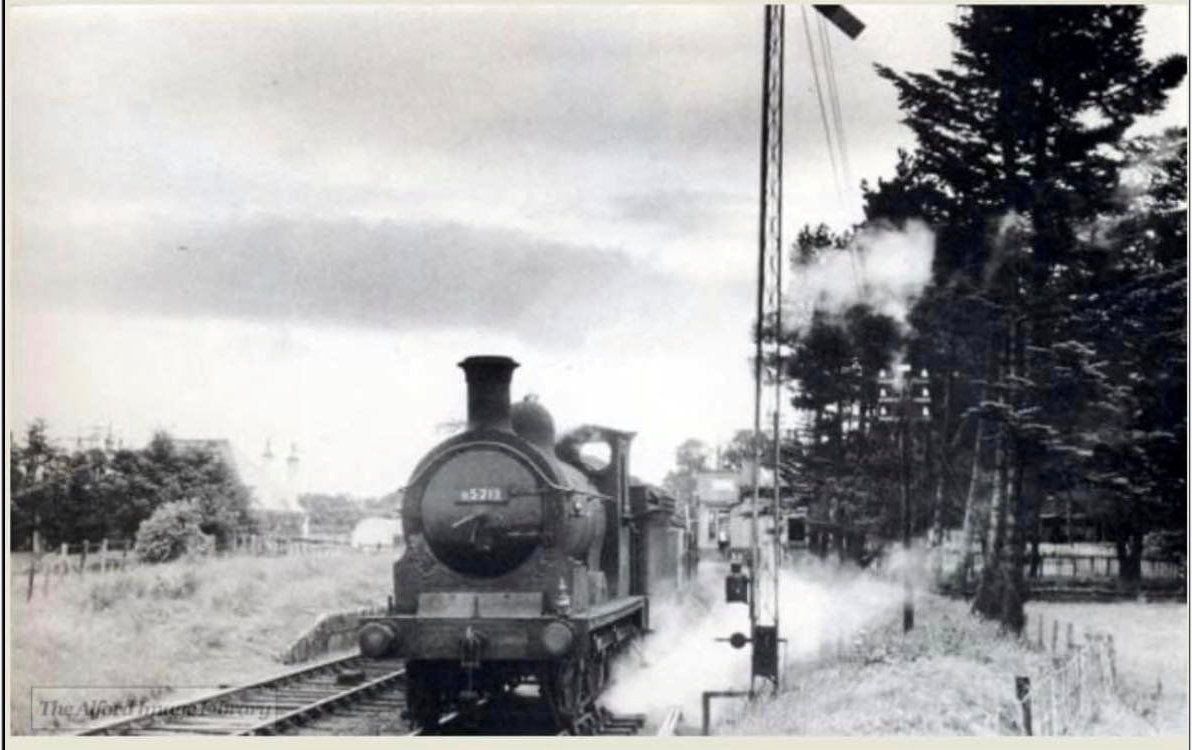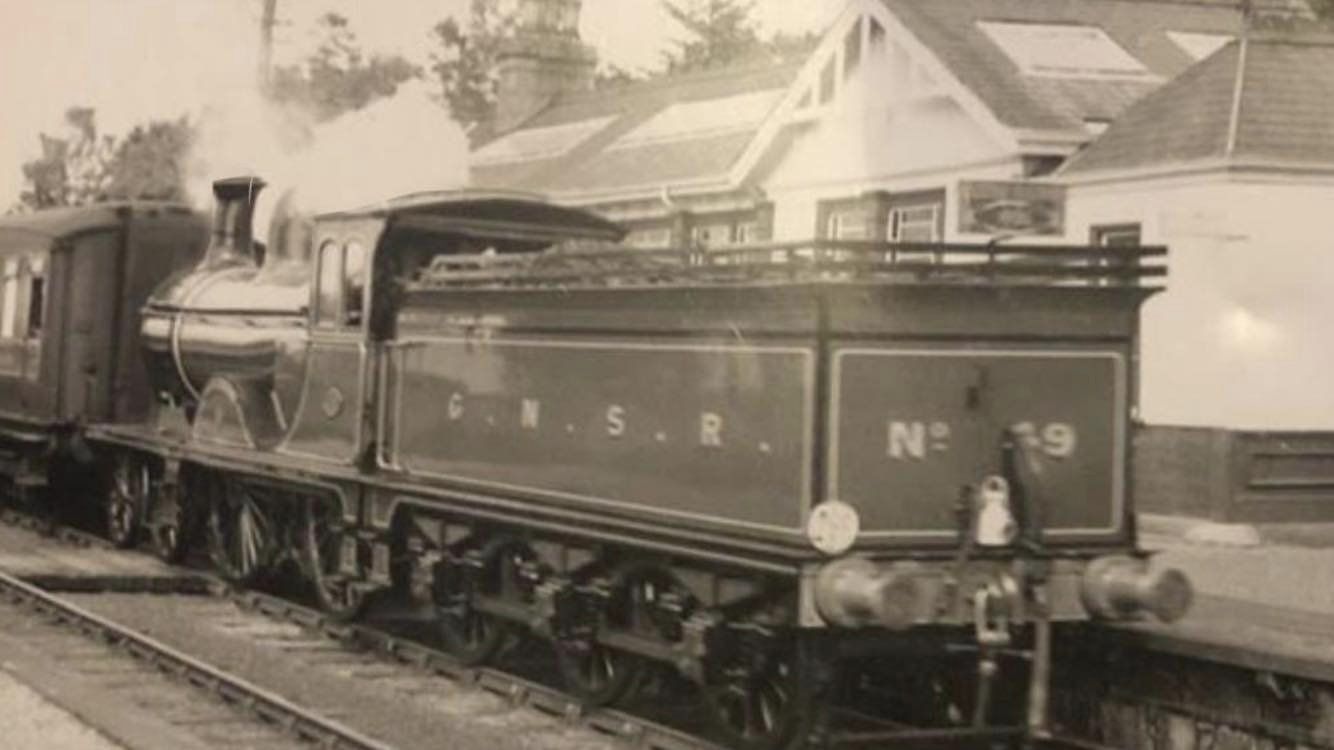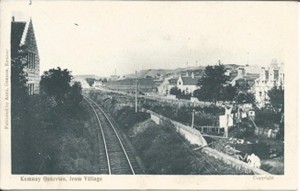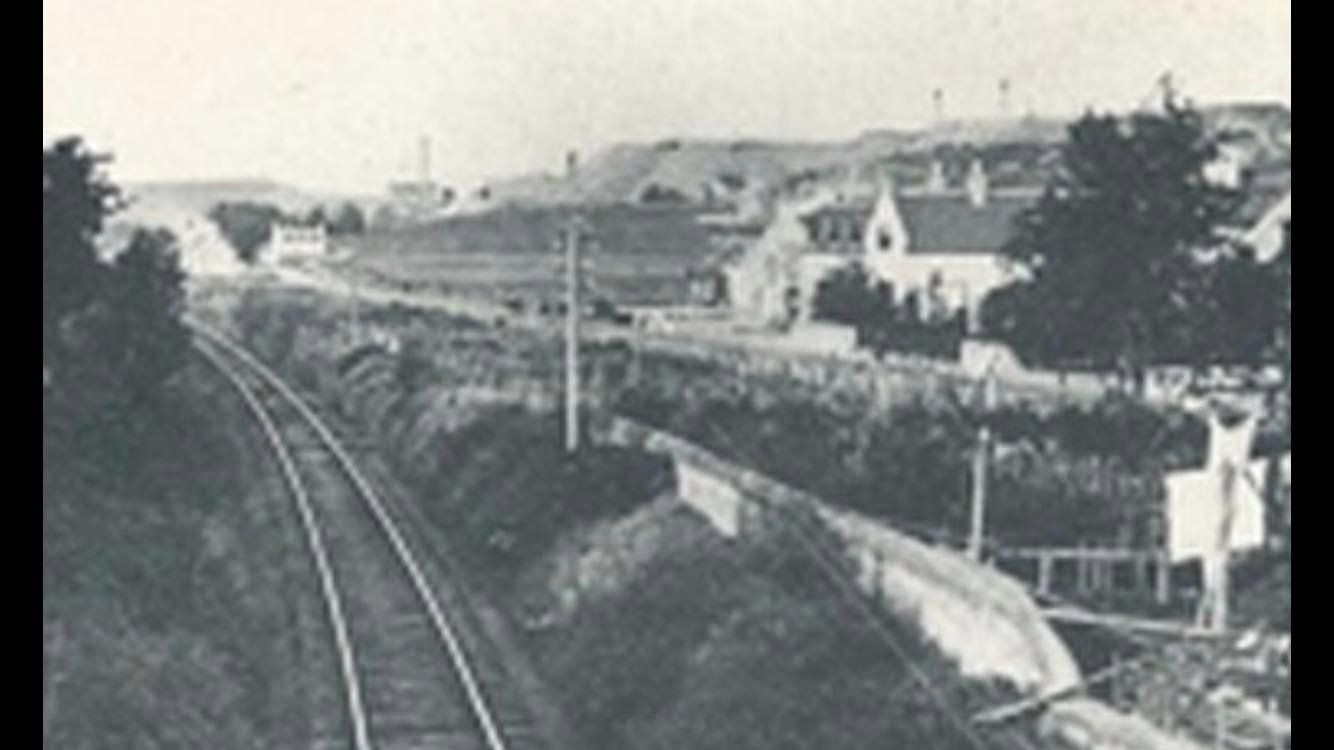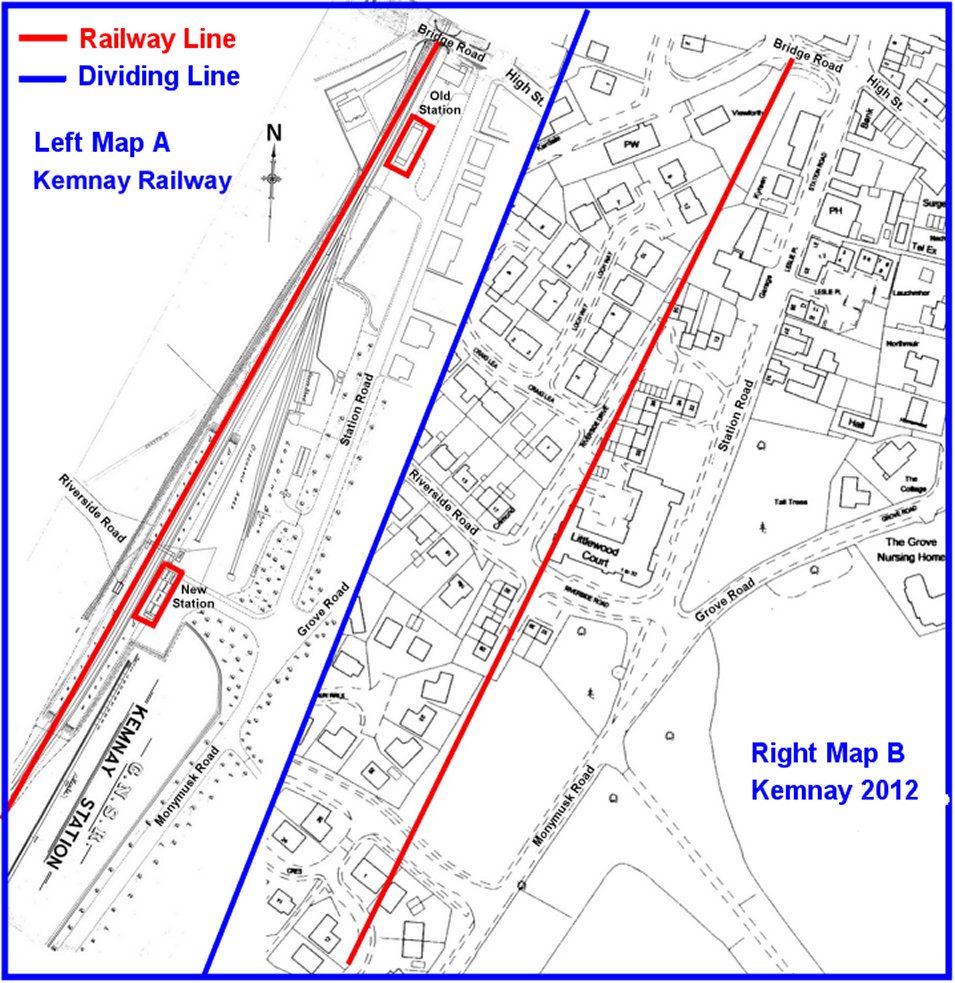Kemnay Railway
The map of the old Kemnay Railway, Map A, is displayed alongside a map of Kemnay in 2012, Map B. The line of the railway is shown in red and the old and new Stations clearly marked. A larger scale map is shown at the bottom of this page.
The following information has been extracted from an article appearing in the Evening Express on 05 July 1980, written by Ian Carter, who at the time of writing was a Senior Lecturer in Sociology at Aberdeen University. At the end of the article it is suggested that a source of further reading is: W Diack, Rise and Progress of the Granite Industry of Aberdeen.
Railways had an enormous influence on the North East’s staple industries. Fishing expanded dramatically and was fundamentally reorganised once fast fish trains could speed “the silver darlings” (herrings), to southern markets. Agriculture benefitted not just through the greater ease with which guano lime and cattle cake could be carried to farms but also the cattle marts that sprang up close to railway stations at – among a multitude of other places – Keith, Turriff and most importantly Kittybrewster, Aberdeen. Railways allowed the new dead meat trade to develop in the middle of the 19th century creating vast fortunes for Aberdeen wholesale butchers and making Aberdeen Angus beef Queen Victoria’s favourite Christmas dinner.
However, Railways had a subtler, though still important, influence than these. They shaped the settlement patterns of the rural North-East. The Deeside line provides a good example. Before the line was built, Kincardine O’Neil was the front rank of Deeside villages. But the line’s promoters sent their rails in a great sweep around Kincardine O’Neil generating growth at Lumphanan and Torphins, while confining Kincardine O’Neil to genteel stagnation.
Kemnay was virtually created by a railway and subsequently became the scene for celebrated developments in yet another major North-east industry, which was granite quarrying and working. It is not quite true to say that the railway created the Kemnay granite industry or Kemnay itself. A settlement did exist in the early 19th century, clustered around Kemnay House, the Kirk and the Parish School, which had more than local reputation. It was little more than a Clachan, however.
Similarly, granite had been quarried on a small scale in the district for some years. In 1830 The Laird Burnett of Kemnay took stone from Paradise Hill for extensions to his mansion. However, the scale of both the settlement and the granite industry expanded greatly in the late 1850’s as a result of railway politics.
The Great North of Scotland Railway (GNoSR), always defended its Aberdeenshire monopoly with vigour. When the Railway’s directors discovered that the Deeside, then a separate and hostile company, were planning a line from Drum, through Echt to Alford they moved quickly to revive an earlier suggestion of a branch from to GNoSR main line at Kintore that would pass through Kemnay and Monymusk to Alford. The Alford Valley Railway was authorised by Parliament in 1856 and opened in March 1859. Always the creature of the GNoSR, it was absorbed into that company in 1866.
Two men realised the potential generated by the Alford Valley Railway in Kemnay. The first was a 28 year old entrepreneur called John Fyfe. In 1858, while the railway was being built, he took a lease of the Paradise Hill quarry, which was very handily placed for the railway. Other quarries sprang up along the new line at Tom’s Forest, Correnie and Tillyfourie – the last being the North-east centre for making kerbstones and all eventually fell into John Fyfe’s hands.
However, Kemnay reigned supreme, partly this was the result of the stone’s nature (it is easily worked for granite), and its glorious pearly silver white colour made it extremely popular for prestige construction and monumental work.
The list of buildings made from Kemnay granite sounds like a roll-call of Victorian Confidence. It was used for several bridges in London and Glasgow, the Liver Building in Liverpool, numerous bank headquarters in London, The Forth and Tay railway bridge foundations, piers and approaches; and in Aberdeen the Town House in Castle Street and the extraordinary Broad Street frontage of larger scale extraction Marischal College. More recently it has been used for the construction of the Scottish Parliament in Edinburgh.
In monumental work Kemnay granite was used extensively for the pediments of important statues; the steps and landings of the icing-sugar statue of Queen Victoria, opposite Buckingham Palace, came out of Paradise Hill.
However, Kemnay quarry became famous for more than the quality of its stone. John Fyfe always sort technical improvements in granite working and many innovations that later became commonplace were pioneered at Kemnay. There he installed the first steam derrick to be used in a granite quarry. A few years later he applied a notion he had got from watching a postman pass a bag of mail across the Dee at Abergeldie by means of an endless rope. He fitted a travelling carriage to an endless rope and created the steam powered Blondin. Named after the famous-high wire artist then at the height of his fame. Fyfe’s Blondin became standard equipment in the world’s quarries for lifting stone from the bottom of the dip to the loading bank.
In 1872 he scored another first when he superceded the primitive and dangerous practice of shot-firing by fuses. He pioneered electrical shot-firing, not only was this safer, it also allowed much larger scale extraction from the quarry. On one occasion, 70,000 tons of granite was blasted from Paradise Hill in one operation. Loaded on a single train, the worked granite from this explosion would fill 9,000 trucks and occupy 30 miles of track. One sees how central the Alford Valley Railway was to John Fyfe’s plans.
As stated earlier, two men realised the opportunities that the railway presented in Kemnay, the other was the local Laird. In January 1860, two years after Fyfe had taken his lease on Paradise Hill and ten months after the railway had opened, the Aberdeen Free Press advertised that: “Mr Burnett of Kemnay has resolved to lay off for feuing and building purposes, about ten acres of ground, in the vicinity of the Station at Kemnay. The situation is both convenient and attractive; besides the faculties of communication which the railway now affords, the ground is in the near neighbourhood of the Parish School, Post Office, etc. It commands a pleasant view of the River Don, and of the surrounding scenery”.
The land was carefully zoned. One section was to see the construction of “Houses for the Railway Servants” and a small Hiring Establishment and Lodging House. Two sections would be given over to village tradesmen, and a third to labourer’s houses. The last section was reserved for “small Villas”. It is this section, around Kendal Road, that gives Kemnay its curious character as a rural clone of Aberdeen’s West End.
We should recognise the source of that character and that is not easy to do in Kemnay today. The quarry is still worked but ownership passed from John Fyfe Ltd. To Bardon Aggregates and is presently (2014), owned and operated by Breedon Aggregates who supply Fyfestone precast reconstituted stone products and aggregates to the building industry.
The Alford Valley Railway has gone and the Kemnay Station site is now occupied by Council houses and old people’s bungalows and yet that railway made Kemnay and its famous quarry. However, Kemnay has evolved and adapted over the years and is now a thriving village. Kemnay has expanded and continues to expand due to housing demand as a result of the North Sea oil boom. There is still some local jobs at Kemnay Quarry but the majority of residents commute to Aberdeen or Inverurie for employment.
The following images appear on this site courtesy of GNSRA. They show a map of Kemnay Station, the approximate location of the old Station and the site of the new Station which was completed in 1901. The last two images show a view of the Station looking north followed by a view of the site as it exists today being along Riverside Drive with Littlewood Court sheltered housing scheme on the right.
- Kemnay Railway With Freight To Alford 01 courtesy of Ian Murray
- Kemnay Railway With Freight To Alford 02 courtesy of Ian Murray
- Kemnay Railway With Freight To Alford 03 courtesy of Ian Murray
- Kemnay Railway Station Aerial View
- Kemnay Railway Station looking SW
- Kemnay Railway Station Children
- Kemnay Railway Station
- Kemnay Railway Station Crowds possibly waiting to see Queen Victoria who visited Paradise Woods on two occasions
- Kemnay Railway Station Crowds
- Kemnay Railway Station
- Kemnay Railway Station New
- Window above entrance doors is exhibited at Grampian Transport Museum, Alford
- Kemnay Railway Station
- Kemnay Railway Station New
- Kemnay Railway Station New
- Kemnay Railway Station New looking north
- Kemnay Railway Station
- Kemnay Railway Station
- Kemnay railway with Quarry in distance
- Kemnay Railway and Quarry
- Approximate position of new Kemnay Station looking north along Riverside Drive
